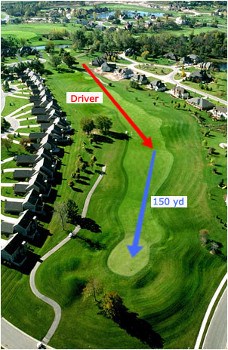Part of golf’s broad appeal is that every course is different.

Some are flat, others hilly. Some are tree-lined, others open to the elements. Some feature dozens of hazards, others very few. And that’s just the tip off the iceberg.
From a design standpoint, courses built prior to World War II tend to play quite differently from those built in the post-war era. Technology explains some of the disparity, since early architects used rudimentary methods for moving and shaping land while modern designers have bulldozers and all manner of machinery at their disposal. Golf equipment advances and stylistic trends played a role, too.
What do these differences mean to the golfer? Potentially, quite a bit. Let’s dive into some of the things you’ll encounter on an older course that you’re less likely to see on a newer one, and how to adjust your game accordingly.
Older courses follow the lay of the land

Without heavy equipment to move mountains of earth, the architects of old placed holes where they fit most naturally; this was also necessary to optimize drainage. Doglegs often, though not always, bend in the same direction as slopes. The same goes for greens, which usually tilt toward water or away from high points.
- Needed adjustments: Survey the course before and during your round, identifying any major topographical features nearby that could influence the ball’s bounce and roll. Think of the direction water would naturally run across the property. For example, if there’s an adjacent mountain, putts may tend to break away from it. On the other hand, they might turn toward a nearby lake or river.
Always look for the high side of a slope when hitting tee shots and approaches. A shot played high on a bank will bounce toward safety and boost distance, while a ball landing too low on the slope may kick into trouble.
Greens are open in front and tilt from the back
Many early designers were either born in Scotland (Donald Ross, Tom Bendelow, James Foulis) or deeply influenced by links golf, a game played as much on the ground as through the air. These men built greens to be accessible with bump-and-run shots by placing bunkers and rough to the sides and leaving the front open. Older greens typically tilt from back to front as well, and often drop off steeply to the back.
- Needed adjustments: American golfers in particular tend to play approach shots to carry all the way to the flag. On courses built during the so-called “Golden Era” of architecture (approximately 1910-1937), this may not be your best bet. After determining your yardage to the hole, size up the area short of the green. If there are no hazards and the ground is relatively firm, a run-up shot may offer a better chance to get it close.
Also, note that shots over the green may be severely punished, and that putts from the back (high side) of the green toward the front could be extremely fast. Keeping the ball below the hole on approaches and chips is critical.
Fairway bunkers are more intrusive

From the 1950s on, designers usually placed fairway bunkers to the sides of fairways to catch errant drives. Earlier architects, again taking their cue from the British Isles, were more inclined to position these traps at various angles. Old-school fairway bunkers sometimes jut into the golfer’s path. It’s not uncommon, in fact, to encounter “center-line” bunkers sitting in the middle of the playing alley.
- Needed adjustments: When spotting a fairway bunker, golfers are conditioned to aim away from it to avoid punishment. But this tactic can cost you scoring opportunities on older tracks. Traps that intrude on fairways create strategic options – risk a drive directly over the sand and the reward may be a shorter approach to the green, or a second shot from a flat stance. If you see a center-line bunker, determine which side (left or right) affords a better angle to the green. More often than not, this will be the narrower side, making it tougher to hit (hence, the risk).
When playing older golf courses, it's essential to adjust your game and approach to accommodate the unique challenges and characteristics these courses may present. Older courses often have distinct features and design elements that can affect your strategy and shot selection. Here are some tips for adapting your game when playing older golf courses:
- Club Selection: Older courses may have shorter yardages or narrower fairways compared to modern courses. Consider using more irons and hybrids off the tee to stay in play and avoid trouble.
- Course Management: Focus on course management and playing strategically. Older courses may have well-placed hazards and smaller greens, requiring thoughtful shot placement and conservative play when necessary.
- Embrace the Classic Design: Older courses often have classic design elements, such as doglegs, blind shots, and natural terrain features. Embrace the challenge and uniqueness of these holes, and avoid trying to overpower the course.
- Pay Attention to Slopes: Older greens may have more slope and undulation, making putting challenging. Take time to read the greens carefully and adjust your putting stroke accordingly.
- Consider Ball Flight: Older courses may have mature trees and tighter fairways. If you tend to hit a significant draw or fade, practice controlling your ball flight to avoid trouble off the tee.
- Play to Your Strengths: Identify your strengths as a golfer and use them to your advantage. If you're a proficient short-game player, focus on getting up and down for pars when necessary.
- Use Course Knowledge: Seek out local knowledge or consult with the course staff to gain insights into the best strategies for specific holes or trouble areas on the course.
- Prepare for Bump and Run Shots: Older courses may have firm and fast conditions, making bump and run shots effective around the greens. Practice these shots to save strokes and improve your short game.
- Be Mindful of Course Conditions: Older courses may not have the same level of maintenance as newer courses. Be prepared for varying conditions and adjust your expectations accordingly.
- Respect the Tradition: Older golf courses often have a rich history and tradition. Take time to appreciate the heritage of the course and respect its unique character.
Q&A:
Q1: How can I adjust my game for older courses if I'm used to playing modern courses? A1: Focus on accuracy and course management rather than trying to overpower the course. Play smart shots and be conservative when necessary.
Q2: Are older courses more difficult to play than modern courses? A2: It depends on the specific design and layout of the course. Some older courses may be more challenging due to narrow fairways and tricky greens, while others may be more forgiving.
Q3: Should I use different clubs when playing older courses? A3: It's possible that you may need to use more irons and hybrids off the tee on older courses with shorter yardages. Be flexible with your club selection based on the course's characteristics.
Q4: How important is local knowledge when playing older courses? A4: Local knowledge can be valuable in understanding the nuances of the course and knowing where to position your shots. Consult with the course staff or local players to gain insights into the course's challenges.
Q5: What are some common mistakes to avoid when playing older courses? A5: Avoid trying to overpower the course and hitting driver on every hole. Instead, play strategically, and be mindful of the course's hazards and unique features.
It should be noted that many modern designers, like Tom Doak and the team of Bill Coore and Ben Crenshaw, build courses more aligned with the classics of yesteryear. These tracks are kept firmer and emphasize the ground game to a much greater extent than those of other modern architects, like Jack Nicklaus and Rees Jones.
No matter what type of course you’re playing, the ability to recognize its demands and opportunities – and adjust accordingly – separates good golfers from average ones.





